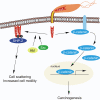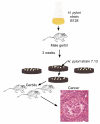Helicobacter pylori infection and disease: from humans to animal models
- PMID: 19048053
- PMCID: PMC2561984
- DOI: 10.1242/dmm.000364
Helicobacter pylori infection and disease: from humans to animal models
Abstract
Informative and tractable animal models that are colonized by well-defined microbial pathogens represent ideal systems for the study of complex human diseases. Helicobacter pylori colonization of the stomach is a strong risk factor for peptic ulceration and distal gastric cancer. However, gastritis has no adverse consequences for most hosts and emerging evidence suggests that H. pylori prevalence is inversely related to gastroesophageal reflux disease and allergic disorders. These observations indicate that eradication may not be appropriate for certain populations due to the potentially beneficial effects conferred by persistent gastric inflammation. Animal models have provided an invaluable resource with which to study H. pylori pathogenesis and carcinogenesis, and have permitted the development of a focused approach to selectively target human populations at high-risk of disease.
Figures



References
-
- Cai X., Carlson J., Stoicov C., Li H., Wang T. C., Houghton J. (2005). Helicobacter felis eradication restores normal architecture and inhibits gastric cancer progression in C57BL/6 mice. Gastroenterology 128, 1937–1952 - PubMed
-
- Chen Y., Blaser M. J. (2007). Inverse associations of Helicobacter pylori with asthma and allergy. Arch. Intern. Med. 167, 821–827 - PubMed
MeSH terms
LinkOut - more resources
Full Text Sources
Other Literature Sources
Medical

